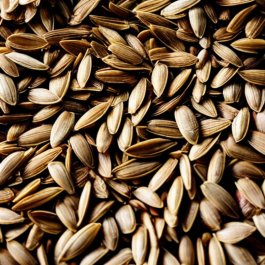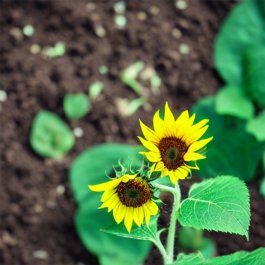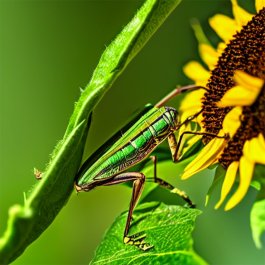
Growing Sunflowers
Sunflowers are one of the easiest flowers to grow—they need lots of sun and love the Summer heat. In fact, sunflowers “follow the sun” as the sun moves through the sky during the day—but only while they’re still growing. Scientists at the University of California at Davis have studied sunflower behavior, and they’re still working on how to fully explain it. But once the plants reach maturity, sunflowers face east and stay there until the flowers fade.
Here are some key benefits and growing tips:
- Sunflowers are low-maintenance flowers.
- Sunflowers have long roots that need room to spread out.
- Because of their height, tall sunflowers can be susceptible to wind damage and may need support with stakes or a wall or fence.
- Sunflowers are heat-tolerant, pest-resistant, and fast growing.
- Sunflowers come in many sizes and colors, including dwarf varieties and flowers in colors other than yellow, like burgundy, orange, and white.
Choose & Plant Your Sunflower Seeds

When selecting sunflower seeds to plant, remember that sunflowers fall into three groups: tall, dwarf, and colored. Tall sunflower varieties can grow up to 15 feet tall … or even taller! Dwarf sunflower varieties only grow to be about 3 feet tall or less, and are perfect for small spaces such as containers, window boxes, and planters. Sunflowers also come in a variety of colors now, thanks to all the hybrid varieties.
Please check out our nine sunflower plant profiles for a guide to the best variety for your needs.
And please remember that while you can get sunflower starter plants at a nursery, growing from seed is super easy and gives you more choices about varieties. Plus, they grow quickly and they really prefer to grow where they’re planted!
Here are some great tips for planning and planting your sunflower seeds:
- Sunflowers love the sun and grow best in places that get 6-8 hours of direct sun per day.
- If you’re growing a giant sunflower variety—those that top 10 feet in height—plant the seeds in a sunny-but-sheltered location or along a fence or wall so they’re protected from the wind.
- Growing sunflowers in pots, containers, or window boxes means choosing a smaller dwarf variety. Just be sure the pot is deep enough to accommodate the taproots.
- Plant your sunflower seeds after the danger of Spring frost has passed and the soil temperature is at least 60 degrees—usually between March and May, depending on where you live.
- Plant sunflower seeds no more than an inch deep and about 6 inches apart. Thin the seedlings once they hit 6 inches tall, leaving the strongest plants about 12 inches apart. (Check your seed packet for precise recommended spacing.)
- For continuous blooms, stagger your planting, sowing a new row of seeds every 2-3 weeks, beginning in the Spring. Succession planting, as this is called, will keep you supplied with continuous blooms until first frost in the Fall.
- The time from planting to blossoming ranges between 65 and 120 days, depending on the variety.
Soil & Watering Requirements for Growing Sunflowers
Sunflowers are generally low-maintenance, but they’ll grow better—and bloom more—if you optimize the soil and properly water them. Here are easy-to-follow soil and watering tips for growing your sunflowers:
- Sunflowers have long roots that need to go several feet into the ground, so sunflower plants prefer loose, well-drained, somewhat alkaline soil with a pH of 6.0 to 7.5.
- Sunflowers are heavy feeders, so they’ll be healthiest and generate the most blooms in nutrient-rich soil that has compost or other organic matter mixed into it.
- When your sunflower plants are small, water the area around the roots, about 4 inches from the plants.
- Once your sunflower plants are established, water deeply but infrequently to encourage the plant to grow deep roots. Water once a week with several gallons of water per plant, more often if the weather is very dry or very hot.
Fertilizing Your Sunflowers

All plants need nutrients to grow and thrive—and sunflowers are no different!
Nitrogen is essential for fertilizing sunflowers, and demand for soil nutrients means fertilizing the soil before sowing your seeds.
Common fertilizers that contain nitrogen, phosphorus, and potassium will work well for fertilizing sunflowers, but test your soil first—your soil might already be ideal for your sunflower plants when it comes to essential nutrients. Contact your local extension center or garden center for information on soil testing. Because sunflowers are hardy plants, they will grow practically anywhere with very little care, but optimizing your soil will maximize your flowering results.
Sunflowers need to be fertilized at the beginning of the Summer, when the new plant is beginning to grow, or at mid-summer when the plant begins to bloom.
If needed, you can apply some slow-acting granular fertilizer—especially in poor, thin soil—because the better you tend to your sunflowers, the bigger and better the flowers!
Caution: Too much nitrogen will increase stem and leaf growth and delay flowering, and you should avoid over-fertilizing in general—doing so will burn the leaves and kill your plants.
Weeding Your Sunflowers
When you plant sunflowers from seeds, plants can take up to two weeks to appear, so weeds can very easily establish themselves, shading the sunflower seedlings and stunting their growth.
The best option for avoiding weeds is to till between the rows—sunflowers can stand up well to mechanical methods of tilling. Till once before the seedlings come up out of the ground, about one week after they are planted. Then till one to three more times after the seedlings have emerged, but before they are tall enough to shade the weeds out on their own. Once the sunflowers have fully established themselves, you can do spot weeding.
Dealing With Sunflower Pests & Diseases

While sunflower problems are few (they really are low maintenance!) you may encounter some problems. Prevention is key: Keeping your garden clean and free of weeds and debris is your best line of defense in preventing sunflower problems from occurring in the first place.
Not many pests bother sunflowers, but the most common sunflower pests include the following:
- Sunflower Beetles: Sunflower beetles typically feed on the foliage and in small numbers—they seldom hurt older plants. However, on younger sunflower plants, the first true leaves can be severely damaged or completely consumed.
- Cutworms: Cutworms can also damage the leaves of young sunflowers, leaving notches or holes. Wilting may also occur. Again, these are usually not major issues unless there is a heavy infestation.
- Sunflower Borers: Sunflower borers and stem maggots burrow into the stems of sunflower plants to feed. This can quickly choke off the nutrient supply of sunflower plants, especially if there are a large number of pests.
- Sunflower Moths: Sunflower moths are one of the most destructive pests to sunflowers, laying their eggs within the flowers. Once the eggs hatch, the larvae move into the flower heads to feed, ultimately destroying the plants.
- Grasshoppers: Grasshoppers and various caterpillars also enjoy nibbling on sunflower foliage. While rarely a major problem, large numbers can quickly defoliate plants.
The best remedy for any of these pests is a good organic insecticide. Treating areas before pests become well-established is a good strategy, and—again—prevention is best, and that means keeping your garden weed-free and clean.
Although sunflowers can be affected by some disease problems, this is rarely an issue, as these plants are typically quite hardy. Various leaf spot diseases may cause surface spots or yellow patches. Rust, verticillium wilt, and powdery mildew can also affect sunflower plants on occasion. However, the most common threat to these plants is Sclerotinia stem rot, also known as white mold. This fungus can cause sudden wilting of leaves, stem cankers, and root or head rot. Crop rotation can reduce the likelihood of this disease as well as proper watering practices—always water at ground level, not from above. And don’t give in to the temptation to plant more sunflowers closer together; if you cut down the air circulation, you’re opening the plants up to potential disease.
It will be the rare instance that you’ll have to treat your sunflowers with insecticides or fungicides—but any organic treatments can help deter pests and diseases.


 Previous
Previous

